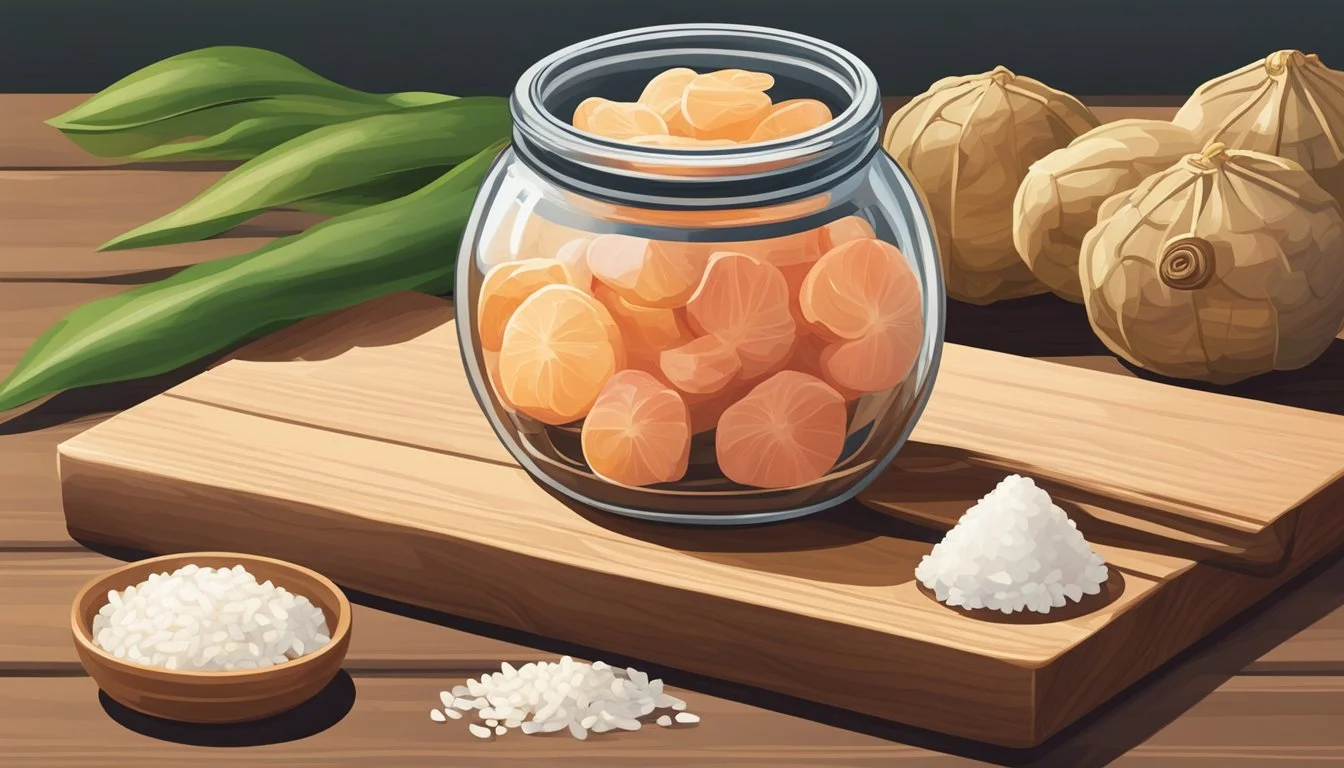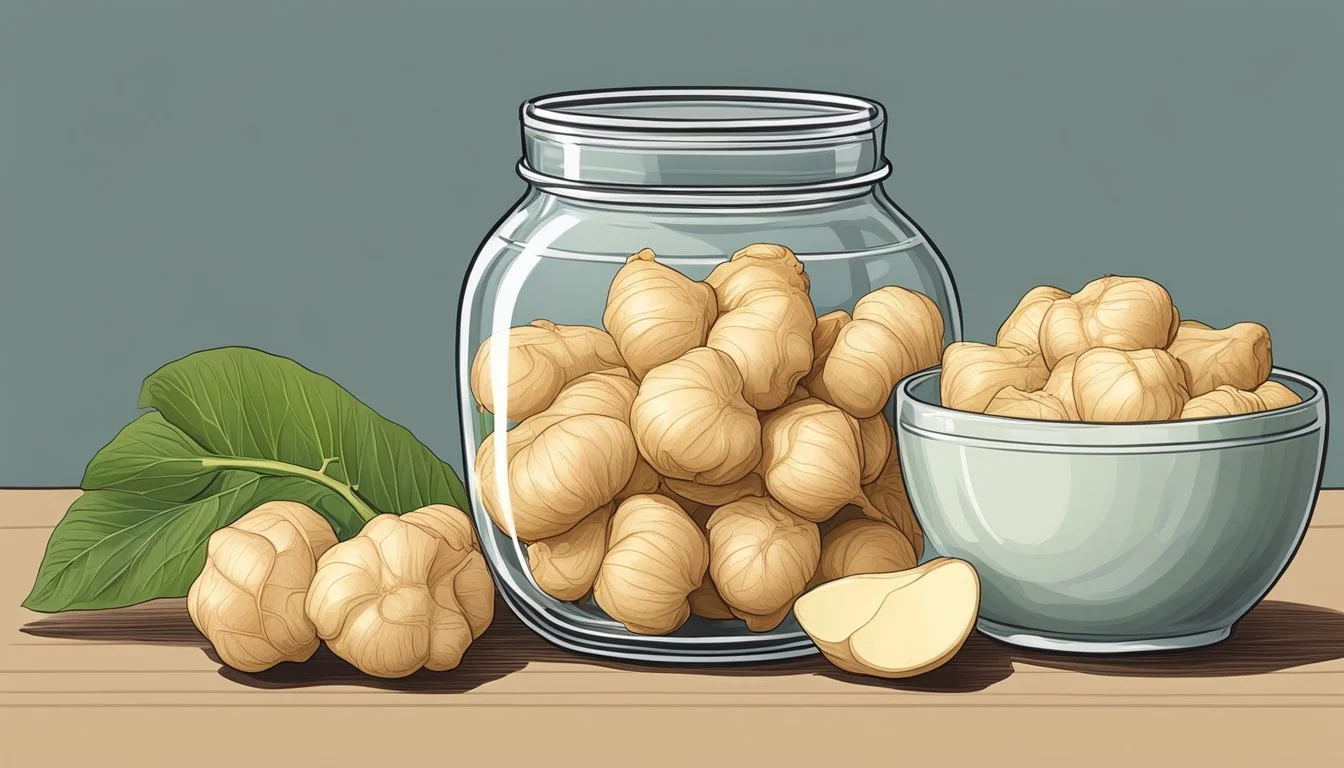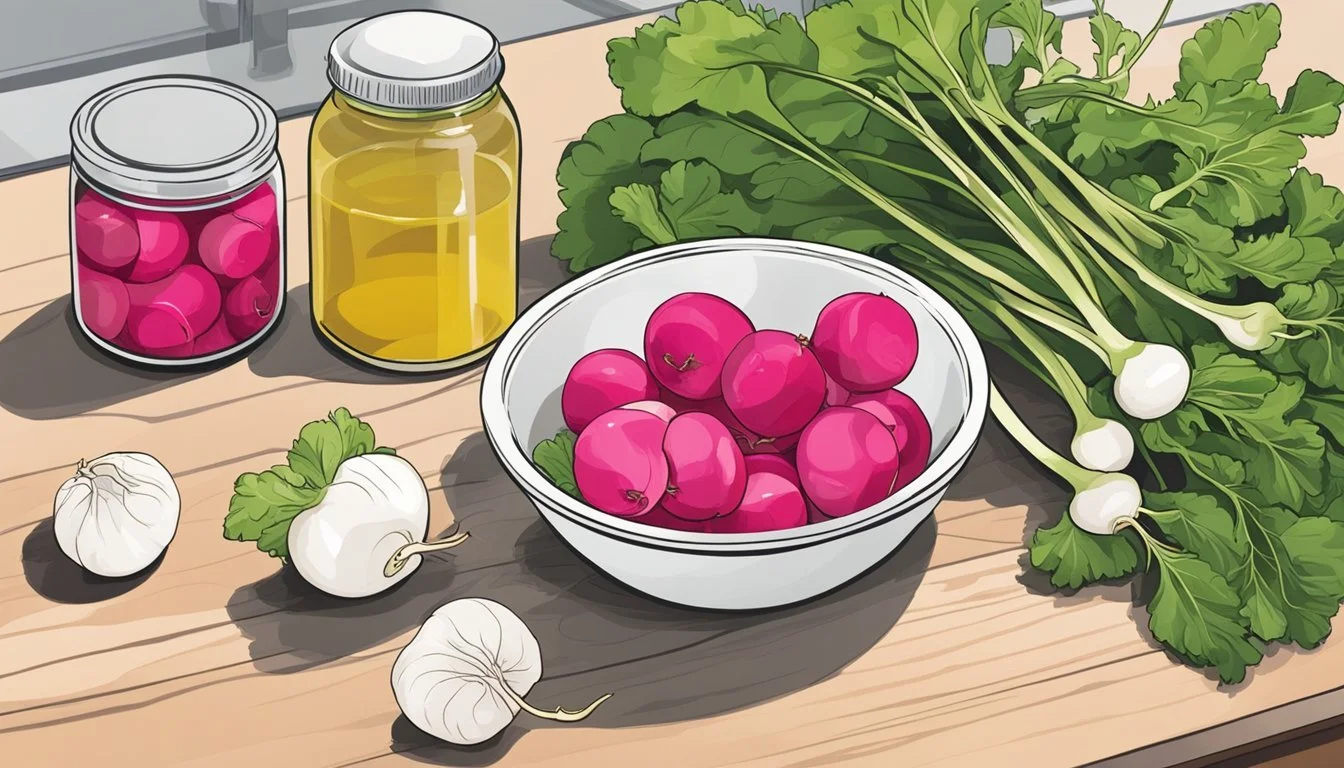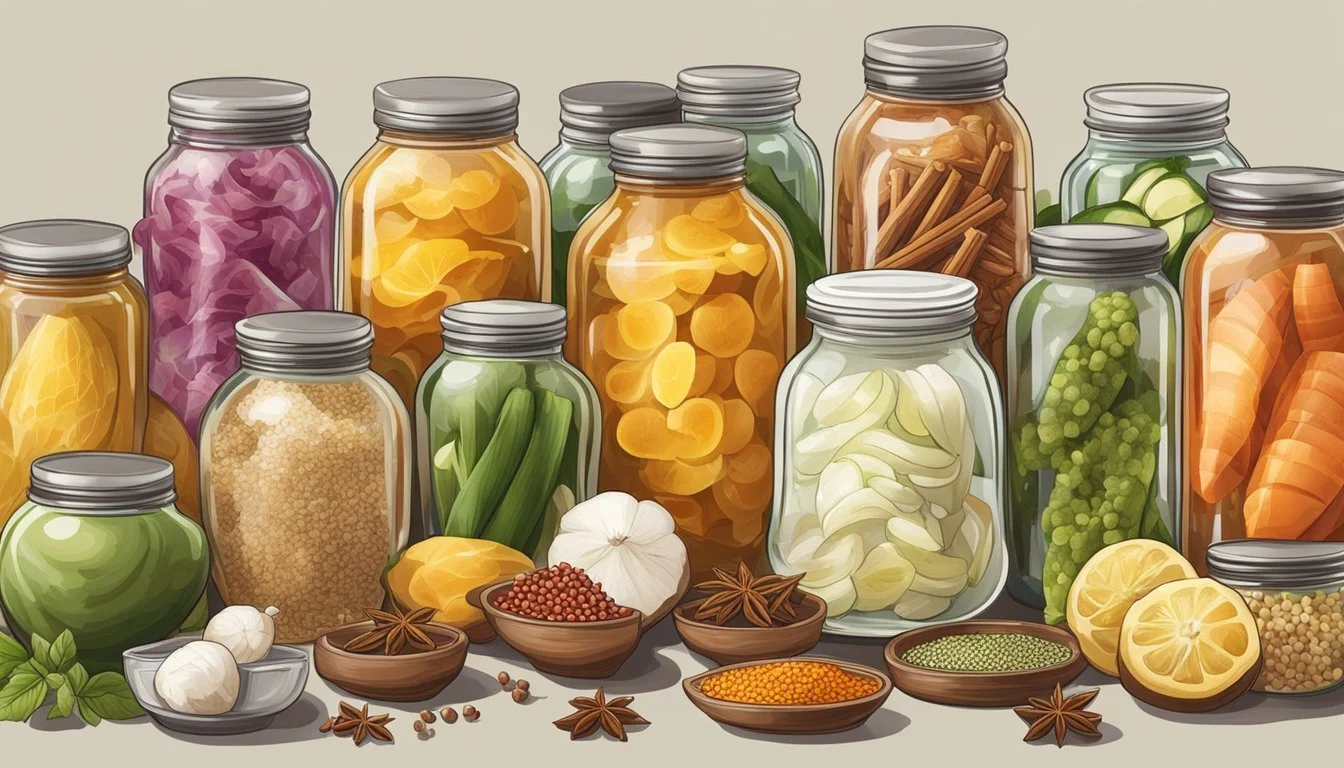Pickled Ginger Substitutes
Top Alternatives for Your Recipes
Finding a substitute for pickled ginger can be a challenge for those trying to replicate its unique tangy and spicy flavors in sushi and other Asian dishes. Whether you’ve run out of it, dislike its taste, or are looking for a different option due to dietary restrictions, there are several viable alternatives available. One of the top substitutes for pickled ginger is pickled plums, which offer a similar sour and slightly sweet profile.
Another excellent option is shibazuke, a mix of various Japanese pickled vegetables that often includes a hint of ginger and can provide a comparable taste and texture. For those who prefer homemade solutions, a combination of fresh ginger soaked in vinegar and sprinkled with red shiso offers a close match to pickled ginger. This simple preparation can bring a hint of authentic flavor to your dishes without having to purchase specialized ingredients.
Additionally, some might find kimchi or fukujinzuke to be intriguing substitutes, each offering distinct flavors that complement many Asian dishes. By exploring these alternatives, anyone can enjoy the vibrant flavors that pickled ginger brings to the table, regardless of availability or preference.
The Role of Pickled Ginger in Cuisine
Pickled ginger plays a vital role in various Asian cuisines, especially Japanese culinary traditions.
It is most commonly associated with sushi, where it serves as a palate cleanser between different pieces of sushi. This helps diners appreciate the unique flavors of each type of fish or roll.
As a condiment, pickled ginger adds a tangy and slightly sweet flavor that complements many dishes. It's often used in stir-fries, noodle bowls, and rice dishes to bring a fresh zing to the meal.
In Korean cuisine, pickled ginger can be found accompanying dishes like kimchi and various banchan (side dishes).
The bright pink or red color of pickled ginger, typically derived from natural dyes such as shiso leaves or plum vinegar, adds a visually appealing element to the plate.
By aiding digestion and refreshening the mouth, pickled ginger not only enhances taste but also the overall dining experience.
Understanding Ginger's Flavor Profile
Ginger stands out for its unique combination of spicy, sweet, and warm flavors. Examining the differences between fresh and pickled ginger clarifies why it’s essential in many dishes. The pungency of ginger makes it a versatile ingredient in both sweet and savory recipes.
Fresh vs. Pickled Ginger
Fresh ginger has a strong, pungent flavor with a slightly sweet and spicy undertone. It is commonly used in both cooking and baking, adding a fresh, vibrant note to dishes.
Pickled ginger, on the other hand, has a milder and sweeter taste. It often accompanies sushi to cleanse the palate between bites. The pickling process enhances its sweetness and reduces its spiciness.
Fresh ginger is frequently used in stir-fries, soups, and marinades, providing a sharp and lively flavor. Pickled ginger is less versatile but essential for certain dishes, particularly in Japanese cuisine.
The Pungency of Ginger
The pungency of ginger is due to compounds like gingerol and shogaol. Gingerol is abundant in fresh ginger and contributes to its sharp, spicy taste. When fresh ginger is cooked or dried, gingerol transforms into shogaol, which is even more pungent.
This pungent quality is what makes ginger a key ingredient in dishes that need a strong flavor profile. It also explains why ginger substitutes need to have robust flavor characteristics. Lemongrass and galangal offer similar pungency levels, making them effective alternatives.
Culinary Uses of Ginger
Ginger's culinary uses are extensive due to its distinctive flavor profile. Fresh ginger is used in Asian, Indian, and Middle Eastern cuisines. It enhances dishes like curries, soups, and teas.
Pickled ginger finds its place in Japanese cuisine, especially as a condiment with sushi. It helps to refresh the taste buds between different sushi types.
For those looking to substitute ginger, options like cinnamon, nutmeg, and cloves can mimic its sweet and spicy flavor in baked goods. For savory dishes, lemon juice with garlic or galangal can replicate its pungency and aromatic qualities.
In summary, understanding ginger's flavor profile helps in selecting the right form of ginger for your culinary needs or finding the best substitute when ginger is unavailable.
Health Benefits of Ginger
Ginger, known for its potent and beneficial health properties, plays a significant role in reducing inflammation, aiding digestion, and managing cholesterol levels. This section will cover three key areas where ginger proves most effective.
Ginger as an Anti-Inflammatory
Ginger contains compounds like gingerol that exhibit strong anti-inflammatory properties. Gingerol, the active constituent, can help alleviate symptoms in individuals with inflammatory conditions like arthritis.
Research indicates that regular consumption of ginger juice or raw ginger may help reduce inflammatory markers in the body. This makes ginger a popular natural remedy for reducing joint pain and stiffness.
Using ginger in daily meals or as a supplement is a practical approach to harness its anti-inflammatory benefits.
Ginger and Digestion
Ginger promotes efficient digestion by enhancing gastrointestinal motility. Its natural compounds assist in quicker gastric emptying, which means food leaves the stomach faster.
For people experiencing nausea, particularly those with morning sickness or motion sickness, ginger can provide relief. Studies have indicated that consuming ginger, in forms such as tea or supplements, can substantially reduce nausea symptoms.
Adding ginger to one’s diet helps in maintaining a more comfortable digestive system.
Ginger and Cholesterol Levels
Ginger has been studied for its impact on cholesterol levels. Some research suggests that ginger can help lower LDL cholesterol, which is often termed "bad" cholesterol.
Regular intake of ginger might decrease levels of harmful cholesterol in the body, thereby reducing the risk of cardiovascular diseases.
It's important to incorporate ginger into a balanced diet to achieve these potential benefits.
By addressing these specific health benefits, it's clear that ginger is not only a flavorful addition to many dishes but also a valuable component of a health-focused lifestyle.
Common Ginger Substitutes
Different substitutes for ginger can be used in various culinary applications, whether you are preparing savory dishes, sweet dishes, or marinades and dressings.
In Savory Dishes
When substituting ginger in savory recipes, options like garlic, turmeric, and galangal provide unique flavors.
Garlic: Offers a pungent and robust flavor, suitable for stir-fries and soups.
Turmeric: With its earthy and slightly bitter taste, it’s perfect for curries and stews.
Galangal: Common in Southeast Asian cuisine, it brings a citrusy punch to dishes.
For those looking for a milder option, lemongrass can also be used. It imparts a fresh, lemony flavor and is excellent in salads and seafood dishes. Aromatic herbs like the bay leaf can add depth to broths and sauces. Each substitute brings a distinct character to the dish, so the choice depends on the desired end flavor.
In Sweet Dishes
In sweet recipes, ginger substitutes need to complement sugary and fruity notes.
Cinnamon: A popular alternative, it adds warmth and spice, enhancing the taste in baked goods like cookies and cakes.
Nutmeg: Provides a sweet, nutty flavor that works wonderfully in desserts like pies and custards.
Allspice: Combines the flavors of cinnamon, nutmeg, and cloves, making it ideal for spiced cakes and breads.
Crystallized ginger can also be used for a closer match to fresh ginger, though it adds extra sweetness due to the sugar coating. When precise ginger notes are necessary, using ginger paste or ground ginger can recreate the familiar taste while adjusting sweetness with other ingredients.
For Marinades and Dressings
Marinades and dressings benefit from substitutes that can blend well and tenderize proteins.
Lemongrass: Adds a zingy, citrus flavor to marinades, ideal for chicken and seafood.
Garlic: Provides depth and pungency, often paired with soy sauce and vinegar in dressings.
Turmeric: Offers a earthy hue and helps in tenderizing meat, especially in marinades for grilled dishes.
Galangal is useful too, especially for Southeast Asian-inspired marinades. The key in dressings is to balance the substituting ingredient with other elements like oils, acids, and sweeteners to maintain harmony. Using these substitutes can impart diverse and enjoyable flavors to your culinary creations.
Specific Substitutes for Pickled Ginger
When seeking alternatives to pickled ginger, there are various options to consider that maintain the distinct flavors. These substitutes can be grouped into vinegar-based, sweet and tangy, and herbal categories to suit different dishes and taste preferences.
Vinegar-Based Substitutes
Rice Vinegar and Lemon Juice: A simple mix of rice vinegar and lemon juice can replicate the tangy flavor of pickled ginger. Combine equal parts of each for a balanced taste.
Plum Vinegar: Plum vinegar offers a fruity and tangy profile, making it a suitable replacement. Use a small amount due to its strong flavor, especially in Asian dishes.
Pickled Plums: These plums provide a similar acidic bite. Thinly slice or chop them and use sparingly as a condiment in salads or sushi.
Sweet and Tangy Substitutes
Honey and Lemon Juice: Mix honey with lemon juice for a sweet yet tangy alternative. This blend works well in marinades and dressings.
Shibazuke: This Japanese pickle, made with vegetables like cucumbers and eggplants in sweet vinegar, adds complexity and a hint of sweetness. It's perfect when you need both tang and a touch of sweetness.
Sweet Vinegar: Combining vinegar with sugar creates a sweet and tangy mix that can mimic the flavor of pickled ginger. Use this mix in small amounts to avoid overpowering the dish.
Herbal Substitutes
Red Shiso Sprinkles: These sprinkles combine fresh ginger with red shiso leaves and vinegar, closely resembling the taste of red pickled ginger. It adds a slight floral note and bright color to dishes.
Myoga: A type of Japanese ginger, myoga can replace pickled ginger due to its mild and slightly peppery flavor. Slice thinly and use it in salads or sushi to provide a fresh, gingery kick.
Fresh Ginger with Vinegar: Grating fresh ginger and soaking it in rice vinegar can offer a quick and effective substitute. This method imparts a fresh and mildly tangy taste, without the need for elaborate preparation.
By choosing the right substitute based on the dish, one can maintain the desired flavor profile even when pickled ginger is not available.
Substitute Incorporation Techniques
When substituting pickled ginger, consider the quantity and ratios, balance of flavors, and texture to achieve the best culinary results.
Adjusting Quantities and Ratios
Proportions are crucial when using substitutes for pickled ginger. If using grated fresh ginger, remember it has a stronger flavor. Start with half the amount called for in the recipe and adjust to taste.
For ginger powder, use one quarter of the amount needed since it is concentrated. When substituting with pickled alternatives like pickled red onions, maintain a similar volume to balance the dish's acidity and sweetness.
Balancing Flavors
Balancing flavors ensures the substitute doesn't overpower the intended taste. Grated fresh ginger brings a fresh, zesty note that can dominate if not carefully measured.
To temper its intensity, combine it with a bit of rice vinegar or a touch of sugar. For ginger powder, mixing it with a liquid component in the recipe can help integrate the flavor more evenly.
Texture Considerations
Texture can impact the mouthfeel and overall experience of the dish. Grated fresh ginger has a fibrous, crunchy texture that differs from the soft, almost gelatinous consistency of pickled ginger.
To mimic this, lightly cook grated fresh ginger or use pickled alternatives sliced thinly. Mixing in other ingredients like diced vegetables or nuts can also help replicate the desired texture.
By focusing on these aspects, substitutes can closely replicate the role of pickled ginger in your dishes.
Adapting Recipes with Substitutes
Incorporating substitutes for pickled ginger can help maintain the tangy and zesty flavor profile in a variety of dishes, from sushi to hearty meat dishes and vegan options.
Sushi and Seafood Pairings
When preparing sushi or seafood, a common substitute for pickled ginger is pickled red onions.
These add a similar tangy flavor and crisp texture. Thinly slice the onions and marinate them in a mixture of rice vinegar, water, sugar, and salt.
Another option is using radish pickles, which can be found in many Asian grocery stores. They provide a crunchy texture and a subtle sweetness, making them an excellent substitute.
For an even zippier alternative, try kimchi, a fermented Korean vegetable dish. It offers a bold flavor with a spicy kick, perfect for those looking to add some heat to their sushi or seafood.
Meat and Poultry Adaptations
For meat and poultry, pickled cucumbers or cornichons can be excellent substitutes. Their tanginess complements dishes like grilled chicken or beef bowls.
In stir-fry recipes, add a splash of rice vinegar and some fresh ginger instead of pickled ginger. This maintains the desired acidity and ginger flavor.
Another alternative is pickled garlic, which can be finely chopped and added to marinades for chicken or beef. Its robust flavor pairs well with savory dishes, enhancing the overall taste without overpowering it.
For dishes like okonomiyaki, a Japanese savory pancake, pickled radish can keep the unique flavor profile intact. Thinly slice the radish and mix it into the batter before cooking.
Vegetarian and Vegan Options
In vegetarian and vegan dishes, pickled beets can be an exciting substitute. They lend a vibrant color and sweet-tangy flavor to dishes like salads or grain bowls.
For fried rice, pickled carrots can be used. Finely chop the carrots and mix them in after the rice has been cooked. This adds crunch and a bit of sweetness.
Another option is pickled daikon, which offers a mild flavor that blends well with vegetables and sauces. It’s particularly good in veggie stir-fry or as a topping for vegan sushi rolls.
In tofu dishes, consider using pickled cabbage for added texture and flavor. It enhances the overall dish without overwhelming the palate.
Other Relevant Spices in Global Cuisines
Various spices across global cuisines share similarities with ginger or offer unique flavors that can elevate dishes. Understanding these spices can help substitute pickled ginger in recipes or add diversity to your culinary repertoire.
Spices Similar to Ginger
Cinnamon: Known for its warm, sweet flavor, cinnamon can replace ginger in both sweet dishes like pumpkin pie and savory dishes. It's particularly prevalent in baking and desserts.
Nutmeg: With a sweet, slightly nutty flavor, nutmeg can be used in place of ginger in various recipes. Ideal for sweet dishes, it works well in custards, baked goods, and even savory items like pasta or meats.
Allspice and Mace: Allspice, embodying flavors of cloves, nutmeg, and cinnamon, is versatile in both sweet and savory dishes. Mace, a subtler version of nutmeg, can also substitute for ginger in similar recipes.
Cardamom: Often used in both sweet and savory dishes, cardamom brings a citrusy, floral note. It’s common in Indian and Middle Eastern cuisines and can be used in baking, curry, and rice dishes.
Ginseng: Specific to Asian cuisines, ginseng can substitute for ginger, bringing a sweeter and slightly bitter taste to soups, stir-fries, and salads.
Unique Regional Spices
Cloves: With a strong, aromatic flavor, cloves are used in both sweet and savory dishes globally. They play a significant role in spice blends and can enhance meats, curries, and pumpkin pie spice mixes.
Candied and Crystallized Ginger: These forms of ginger offer a sweet, chewy texture, useful in baking and candy making. They provide the characteristic heat of ginger in a less intense form.
Pumpkin Pie Spice: A blend of cinnamon, nutmeg, ginger, and cloves, this spice mix is often used in sweet dishes, particularly in autumnal recipes like pumpkin pie and cakes.
Kimchi: This Korean staple, fermented and spicy, incorporates varied spices. Though not a direct substitute for ginger, it offers a tangy flavor useful in certain dishes as an accompaniment.
Ginger Paste and Minced Ginger: These prepared forms of ginger provide convenience without compromising flavor, ideal for quick incorporation into soups, stir-fries, and marinades.
Understanding these spices enables cooks to diversify their use of flavors and find creative substitutes for pickled ginger in a variety of dishes.
Preserving and Storing Substitutes
When preserving and storing alternatives to pickled ginger, understanding the unique requirements of each substitute is essential.
Fresh ginger should be stored in a cool, dry place, or in the refrigerator where it can last for several weeks. To extend its lifespan, it can be frozen; simply peel and slice before placing it in an airtight container.
Ginger paste, often preserved with oil, should be kept in the refrigerator. It remains usable for a few weeks. Portioning it into an ice cube tray and freezing can extend its shelf life, making it easy to use as needed.
Kimchi, a fermented condiment, should be stored in the refrigerator. Its fermentation process continues even when chilled, enhancing the flavors over time. It can last several months when properly stored in a sealed container.
Pickled onions can be prepared and stored in vinegar. Keep them in the refrigerator in a tightly sealed jar. They typically stay good for several weeks.
Crystallized ginger is another option. This dried ginger variant, coated in sugar, should be stored in a cool, dry place, ideally in an airtight container. It can last for several months without losing its flavor.
For all vinegar-based substitutes, like those involving rice vinegar or ume vinegar, store them in sealed jars in the refrigerator. The acidic environment helps preserve these for extended periods.
Proper storage ensures that each substitute retains its flavor and texture, ensuring that they are ready to use whenever needed.









